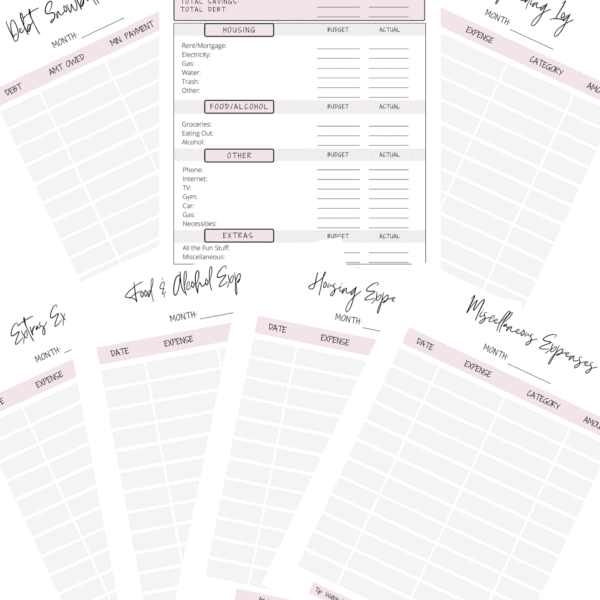With many of us conducting our jobs and business at home, I've put together the best professional tips for video conferencing.
Who else is still being asked to work from home? This girl!
Truth be told, I actually always work from home in my day job. (I have a demanding day job and only run TFC at night/weekends.) However, I typically travel around the county meeting clients. I'm used to having meetings with clients in person so the new way of life has certainly changed the way my industry does business.
My calendar is filled with video conference meetings all day every day.
I recently took a very expensive training on professional tips for video conferencing. I took good notes and figured I'd share what I learned with my readers.
Whether you meet with clients or have internal calls with your peers, these professional tips will help you gain further credibility in your current job.
If you'll be giving a presentation, you can apply all of these tips to your presentation for the most professional look possible via a video conference call.
Related:
- Job Resume Template: How-To Guide That Will Make You Stand Out
- Ultimate Guide to the Best Questions to Ask in an Interview
P.S. If you haven't seen Tripp & Taylor's Video Conference Call in Real Life, take a look below for a good laugh.
Alright, let's get in to the tips you need to have the most productive and effective video conference call.
Professional Tips for Video Conferencing
1. Put the Camera at Eye Level
Do your best to place the camera at eye level.
If you are using the camera from a laptop, put a few books under the laptop so that the camera is eye level. It can look like you're gazing down on your viewers if the camera is below you. Plus, it can sometimes give an unflattering view of your beautiful face.
On the contrary, make sure the camera is not above your head, causing you to look up. That can make you look less confident and unsure of your presentation materials.
The closer to eye level your camera is, the more engaged your attendees will be.
2. Look at the Camera Instead of the Screen
One of the best tips for video conferencing is to look at the camera, not the screen. This tip is GOLD as this makes a HUGE difference in the engagement of your viewers.
When you look at the screen, it looks as though you aren't looking at your viewers, even though you're looking at their faces on the screen. This causes them to disengage.
However, when you look straight at the camera, your attendees will feel as though they are looking right at you. This will increase engagement and professionalism.
It's difficult at first to not look at the faces of your viewers, but it gets easier with practice and is a total GAME CHANGER!!
3. Talk Slowly
This is something I really struggle with sometimes.
I am naturally a very fast talker. I don't like to waste time and I like to get right down to business. I also appreciate fast talkers in life. (I know, I know, I'm working on “slowing down” in life in general. There's a theme with me. Haha.)
However, I must focus on talking slower to get my points across in a more effective way.
When you talk slower, you are able to think through your words more effectively to give a better presentation.
In addition, the information is better retained by your viewers because their brain can process each individual word. When you talk fast, it often takes the receiver's brain longer to comprehend what was just said. By the time they comprehend, you're already onto the next sentence.
Make it a point to speak slower. Trust me.
4. Insert Pauses in Your Presentation
This is a great tip and I'm working on this one as well.
Ever heard a motivational speaker? Listen to how they speak.
They speak slowly and they will often pause between sentences.
They do this because it engages the listener even more. It allows the listener's brain to register the last sentence and prepare for the next sentence.
This can be awkward to do on a video conference call. I even have felt awkward trying to implement it. However, I have noticed that the times I do, my audience perks up. The silence is uncommon for them as well so it causes them to listen intently to what I'm going to say next.
Try it on your next presentation!
5. Join the Call 10 Minutes Early
In a normal conference room setting, people come in as they are available. Some people will be 15 minutes early, other people will come in 5 minutes before. In this situation, it allows you to build rapport with each person.
You typically ask how their day is, comment on the weather, or talk about weekends, family, etc. This helps you build relationships with your colleagues and clients.
However, in a video conference setting, we are no longer able to do that. What should you do to stay in the limelight?
Join the call 10 minutes early.
If you're giving a presentation, this will allow you to get set up and to greet your attendees as they stroll in. You can easily build rapport this way.
If you're joining an internal meeting with peers, it will allow you to get to know them better. The more you network at your organization, the more opportunities you'll have down the line. After all, we all know it's about who you know, not necessarily what you know.
Take advantage of this time to get to know people on a different level. Treat the video conference as you would a normal conference room.
6. Be the Last One to Leave the Call
Ever been on a video conference call that's wrapping up and everyone says bye, but then someone asks an additional question and everyone stays on another 10 minutes?
Did you notice anyone that dropped off quickly, not realizing there was more to the meeting?
Don't be that person. It doesn't put you in a good light with your bosses, peers or clients.
If you're in a meeting with your boss, make sure they leave the meeting first in case they have additional questions.
If it's a meeting with your peers, stay on until you're the last one to make sure you stay in the loop on the entire conversation at hand.
If you're hosting a client meeting, let the attendees know that you'll stay on after the call to answer any individual questions or for additional conversation.
7. Stage the Room Behind You
This may sound silly, but it's not.
Your peers, boss, and clients want to see something that's aesthetically pleasing when they're speaking with you.
Best practice is to have your back 5-7 feet away from a wall. However, you should have some things in the background so that the viewer has things to look at.
For example, a bookshelf with picture frames, books and decor is perfect! A table with a lamp and flowers is also a great look.
In addition, you can take it a step further and put a hobby of yours in the background. I have colleagues that have records on the wall, frisbees, golf memorabilia, professional sports teams, etc. I have some marathon running certificates in my background.
These items will often start conversations with the attendees and demonstrate common ground. It's a great way to break the ice!
My peers and clients immediately learn something about me just from my video conference view. It's a unique way to get to know people.
8. Set Meeting Agenda Beforehand
If you're hosting the meeting, send out the meeting agenda beforehand.
This way, your clients/peers will have the opportunity to add things to the agenda or have questions prepared.
You want your clients/peers to know exactly what this meeting with entail so that everyone can come to the call fully prepared and ready to interact.
For clients, I send something similar to this:
Meeting Agenda:
- Team Introductions
- Overview of XYZ
- Status of Current Action Items
- Advantages of XYZ
- Next Steps
It doesn't need to be long or intense, just concise and to the point.
9. Imagine You're Talking to One Person Instead of Many
Here's another one of the best tips for video conferencing.
When you're giving a presentation, picture one person that you can target your presentation to.
Use words like “you” instead of “you all”. You want the viewers to feel like you're talking to them instead of a group of people.
This will help you with engagement and will assist people with listening more intently to your content.
10. Change Your Voice from High to Low
When people are listening to a video conference (as opposed to in person), it can be very easy to start multi tasking and not pay attention.
To keep your viewers' attention, change your voice up. Talk high and then change your voice to low.
You don't need to change it every second, but try to avoid sounding “monotoned”. Changing up your voice will keep them on their toes.
11. Switch from Presentation To Camera
If you're showing your screen and giving a presentation, one of the best tips for video conferencing is to switch back to camera mode multiple times through out your presentation.
Showing your slides for extended periods of time can cause you to lose your viewers. They may start multitasking and become unengaged.
If you continuously change back and forth, you'll keep them more engaged in your presentation.
12. Turn Your Camera On…Always
Since we aren't in person, you'll need to go the extra mile to get noticed at work as an employee.
Because of this, make sure you're always on camera for meetings. This is a rule not just for people that work with clients, but for anyone. You want your face to be seen by your peers and boss on a daily basis so that you're constantly in the fore front of their minds.
Your name on a screen won't do much for your career. If your goal is to grow in your career, get a raise, etc, show them that you are fully engaged in every meeting by having your video on.
13. Ask Questions
To piggyback on the above topic, make sure to also ask questions. Since you aren't in person, it's even more important that you demonstrate your engagement.
If you meet with peers/managers, asking questions on each call will show them you're engaged and present. It also shows them that you care about the business and about your career.
Managers love people that ask questions. In addition, your peers may benefit from a question you ask. It's a win win all the way around!
If you meet with clients, asking questions will keep your clients engaged and allow you to find out more about their business.
14. Listen Intently
When I say listen intently, I mean that when your peers/clients are talking, show them you are listening.
How do you do that?
Nod your head, write notes, look straight at the camera, etc.
I like to nod my head quite a bit so they know I'm listening and understanding what they're saying. This helps me stay engaged with what they're saying. I also think about what question I can follow up with to confirm the ideas they presented.
15. Keep Your Hands Off Screen
Keep your hands to yourself during a video conference call. There isn't much real estate on the screen so anything additional will cause your viewer to get distracted.
It's okay to use your hands for a minute to explain something, but try to keep them by your sides as much as possible.
You want your viewer focused on the content of what you're saying, not your hands flailing about. =)
Tips for Video Conferencing to Start Now
I know many of us have “permanent” work from home jobs now so let me know if this was helpful! If there's any questions you have, please feel free to ask!
I'm happy to share experiences and knowledge as much as I can.
Has your company sent you to a “work from home” model for good? Let me know in the comments! =)
Related:
This website is a participant in the Amazon Services LLC Associates Program, an affiliate advertising program designed to provide a means for sites to earn advertising fees by advertising and linking to amazon.com.


It¦s truly a nice and useful piece of information. I¦m glad that you just shared this helpful info with us. Please keep us informed like this. Thank you for sharing.
Good day! This is my first comment here so I just wanted to give a quick shout out and tell you I genuinely enjoy reading your blog posts. Can you suggest any other blogs/websites/forums that deal with the same subjects? Thanks!